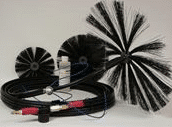Here's finally a definition for cleaning!
Washing and cleaning of surfaces or buildings according to Cleaning Experts
In the first place, cleaning is the action of removing dirt! Maintain cleanliness by cleaning something regularly and preventively.
To begin with, dirt is removed by mechanical means, such as brushing or spinning, sweeping.
In addition, dirt is also removed with chemical or biochemical products. Degreasing, sanitizing, polishing, stain removal, etc. are used. More often than not, there will be a combination of physical and chemical action for effective cleaning. We're going to brush a carpet with a carpet cleaner for example.
Some notions of physics also help to better understand cleaning processes. The same product can be used with the same mechanical cleaning action. With very different results depending on the temperature of the cleaning product. In general, heat increases the efficiency and speed of cleaning.
In addition, when you regularly clean a surface, a place or a property, it is referred to as care or maintenance. Keep surfaces or places clean, don't let dirt accumulate. Maintaining or maintaining cleanliness improves the look and comfort of a space.
This prevents premature wear and tear in the case of maintenance of a carpet, or a car for example. Cleaning methods use chemistry, physics as well as mechanical and even biological means.
Also, cleaning chemistry is the science that determines which chemical will have which property and will be useful for a certain type of cleaning. The cleaning technique indicates the physical action to accomplish the cleaning, most often this will involve the use of equipment
Mechanical cleaning
There are also the mechanical actions used for cleaning such as brushing, shaking, a surface in order to remove dirt. Shaking a carpet every week is an effective way to clean it against dust, crumbs and sand.
For example, an effective cleaning action will be achieved by combining the use of a product in combination with a physical action. This is the case, for example, with the washing machine, which will give movement to the cleaning solution in which dirty clothes that you want to clean are submerged. The chemicals will dilute very specific stains as well as the grease.
Example of ventilation duct cleaning

The dust collector for cleaning ducts
For example, we have just seen that a nozzle will dislodge dirt all along air ducts, sometimes 20 or 30 or 40 feet long. So at the other end of the duct, a device called a dust collector will suck up the dirt with a very high air flow. This is referred to as pulse, friction and suction cleaning. A large amount of air is blown into one duct and at the other end a large amount of air is required, a strong air current is seen to appear and the dust dislodged by brushing will then be transported out of the ventilation ducts, regardless of the length of the route to be made.
Biocide in ducts
Finally, still with our same example, once the dirt has been dislodged from the ducts by pulsation, friction and suction, we proceed to a final step to complete the cleaning with a chemical action. That is to say, a product will be blown in the form of a mist into the ducts after dedusting, in order to sterilize the inside of the air ducts against any possible microscopic particles of bacteria, viruses or mold that have remained stuck somewhere in which case the biocide will eliminate the harmful micro-organism not simple contact ensuring in the end, Healthy air in the ventilation system. Visit our Ventilation Duct Cleaning page to learn more.
Other Specialty Cleanings
Ultrasonic Cleaning

The item to be cleaned is submerged in a basin. Ultrasound will be emitted into the pool to quickly obtain an exceptional clean result through the vibrating action that the ultrasound produces in the water.
The most well-known example is ultrasonic cleaning of slatted blinds. The plastic blinds including the mechanism and the small cords come out like new from ultrasonic cleaning.
Finally, ultrasonic cleaning consists of vibrating the item to be cleaned while it is immersed in a degreaser solution.
Biochemical Cleaning
Nevertheless, the use of enzymes for cleaning removes dirt by destroying it through a biochemical action.
It is a biochemical action, i.e. the action of natural biological matter with a more effective cleaning effect than enzyme-free chemicals on organic matter.
Biochemistry, according to the website of the Faculty of Medicine of the University of Montreal. It defines itself as "an experimental science that aims at the study of the chemical processes at the basis of life." This is the boundary between chemistry and biology.
Enzymatic Cleaning

Enzymes are proteins and there are a variety of them. Some enzymes are used to clean up a contaminated area following an oil spill, for example.
The enzyme used for carpet cleaning is transported in the form of an inactive powder with the addition of detergent as mentioned on the Prochem website. This company is a leading manufacturer of professional cleaning products distributed worldwide.
Enzymatic cleaners
It is true that enzymatic cleaning is a good example of biochemical cleaning. Once activated, the cleaning solution will be effective for a set amount of time.
Temperature will greatly influence the effectiveness of an enzymatic cleaner solution. Here we see that all the sciences are intertwined. It takes a physical action that will heat water, a mechanical action to dilute the enzymes in the hot water and apply the solution to the surface to be cleaned.
In conclusion, the ideal is to add the mechanical action of a carpet extractor to rinse and suck out the mixture of hot water, enzyme and dissolved dirt out of the carpet.
Food research laboratories test the cleaning action of various enzymes. Each enzyme will have a particular purpose, alone or in combination.
One enzyme will be more effective on meat residues, another on dairy products and another on soybean extract for example.
Scientific contact(s) on the study of enzymatic cleaning processes:
- Christine FAILLE (03 20 43 54 04) INRA-UR Food Process Engineering and Technology, 369, Rue Jules Guesde, BP 20039, 59651 Villeneuve d'Ascq Cedex
- Yannick LEQUETTE (03 20 43 54 04) INRA-UR Food Process Engineering and Technology, 369, Rue Jules Guesde, BP 20039, 59651 Villeneuve d'Ascq Cedex
REALCO contact:Gauthier Boels (R&D Manager) - S.A. REALCO N.V., Science Park, Avenue Albert Einsteinlaan, 15, B-1348 Louvain-la-Neuve (Belgium) (+32 (0)10/45.30.00)
The Physics of Cleaning
The principles of physics are often used to understand cleaning.
In addition, in dry cleaning, for example, a solvent will dissolve a stain and it will volatilize, the heat will multiply the effectiveness of the solvent.
In contrast, liquid nitrogen in a pressurized can will be used to freeze gum on a carpet to harden it to break it up with a hammer and pick up the pieces.
It can be seen that both cold and heat can be used in a specific cleaning operation.
Dry cleaning
First, a 25-page study, "The major families of organic solvents. Physico-chemical use of solvents" available on the Université de Montréal website explains in great detail the interactions between the physics and chemistry of solvents used for cleaning.
This study is one example among many that explains why several actions combined with a change in the temperature of the cleaning agent or the surface to be cleaned are often necessary. This will be used to produce a desired action, e.g. cleaning. We could talk about Physico-cleaning here.
Dry ice cleaning

The CO2 particles are blown away by a device and hit the surface to be cleaned at supersonic speed to create an impact shock with the dirt, lifting it up very quickly.
CO2 evaporates without leaving any ecological footprint. From a "physicocleaning" point of view, if I may use the expression, the modification of the solidity of CO2 by cold makes it possible to use these solid particles as an abrasive for pressure cleaning. A natural abrasive that sublimates during cleaning.
Ozone Cleaning
Finally, in the cleaning industry, ozone is used to disinfect, decontaminate and deodorize spaces during a major cleaning. To do this, a machine that produces ozone must be installed in a place to be cleaned.
Also, the power of the machine must be proportional to the volume of the space to be treated. Ozone acts as an ultra-effective cleanser and biocide. In professional cleaning, we use ozone in addition to chemical surface cleaning.
When cleaning carpets with a strong odour, we will have them stay for 24 hours in a room reserved for ozone treatment, the same method also applies to furniture cleaning.
High concentration of ozone acts on air like chlorine does on water
Now, think of a carpet that smells of skunk urine, a warehouse full of rotting food, or a residence with a decomposing body, or a fire.
In all these situations, the use of ozone will be the only way to completely eliminate the bad smell permeated in the premises that will persist after more traditional cleaning with specialized chemicals.
This is a place that is being cleaned by ozone and that must be hermetically sealed and no one should enter it. The machine will be programmed to stop automatically after a predetermined period of time.
Cleaning Product Labelling and WHMIS in Canada
All professional cleaning products marketed in Canada are tested and will be labelled according to a WHMIS code that defines the potential health risks of a cleaning product to workers who use it.
In conclusion, it is possible to take training to fully understand the cleaning chemistry and labelling system of WHMIS. This measure is intended to allow for the safe use of the wide range of cleaning products available to cleaning professionals.
Some synonyms for cleaning
Synonyms for the word cleaning according to the Larousse dictionary: Balayage, dégrage, dégreasing, lavage, savonnage
Synonym of the word cleanse according to the Bordas dictionary of synonyms: neat, polish, scrub, detach, uncoil, brush, wash, dust, wipe, snuff, strip, cloth, scrub, rinse, swab, scramble, wax, beat, whiten, peel, scrape, rake, weed, curate, skim, sort, winnow, brick, sanitize, strangle, flash, cap, groom, wash, clean, cleanse
You may also be interested in our page on industrial cleaning.
ALSO COMING SOON ARE STATISTICS ON THE CLEANING INDUSTRY AS WELL AS A SECTION ON THE HISTORY OF CLEANING. A SECTION OF EXPERT CLEANING TIPS, ANECDOTES, AND ADVANCES IN CLEANING RESEARCH.
Other sources used to develop this text on cleaning:
Udm website,
Safety Canada,
of Prochem
http://www.lenntech.fr/





